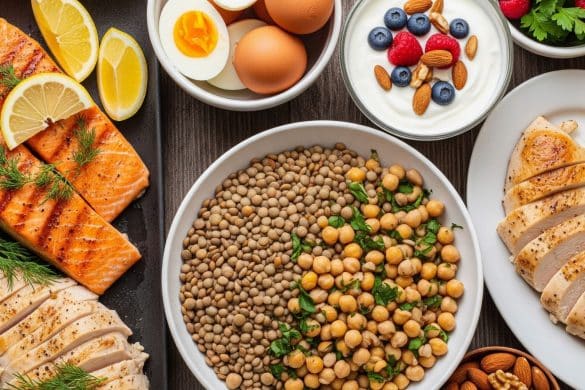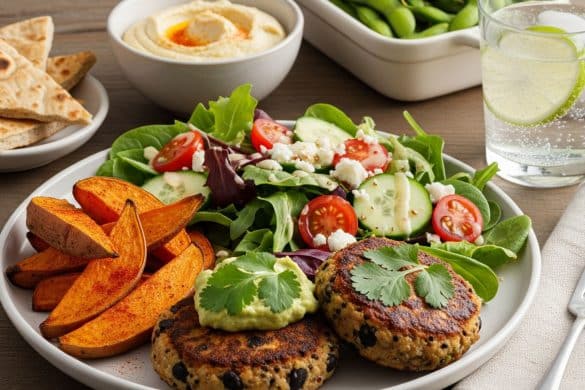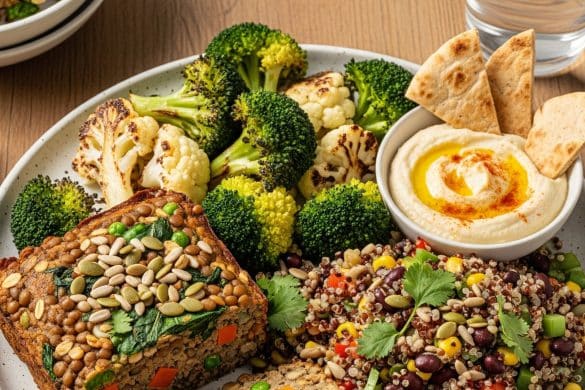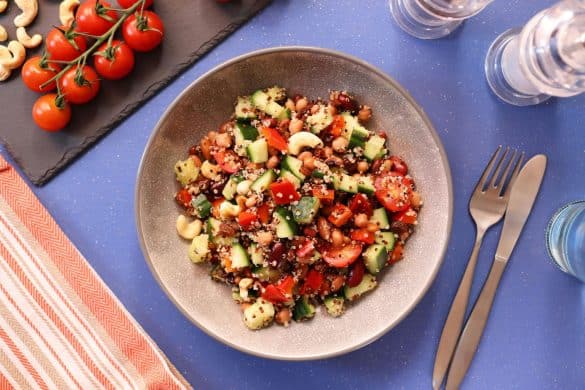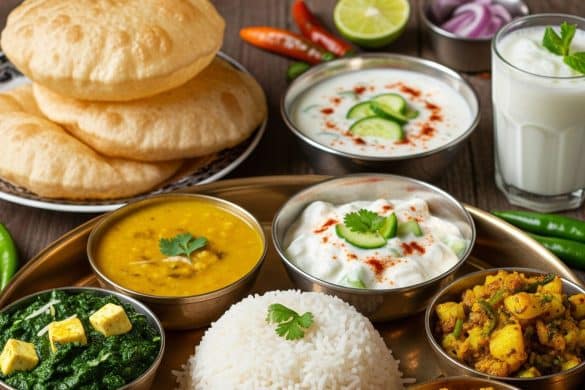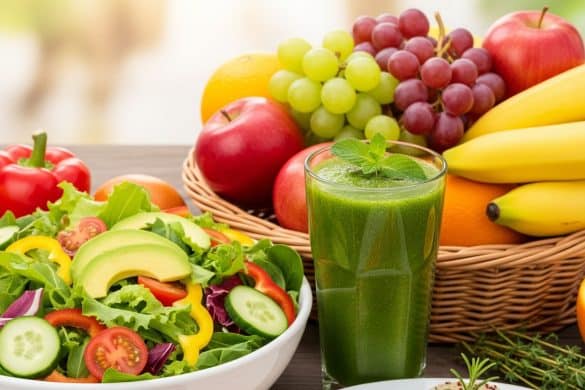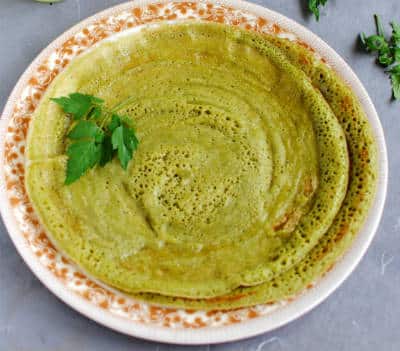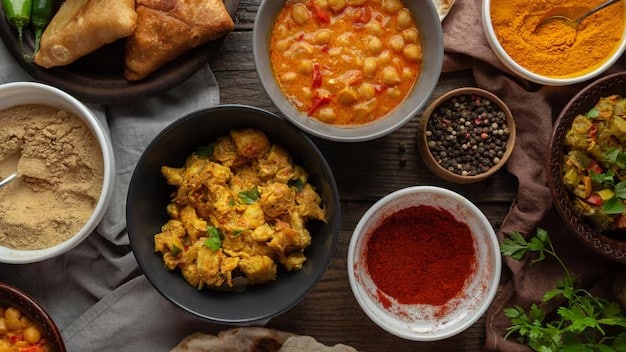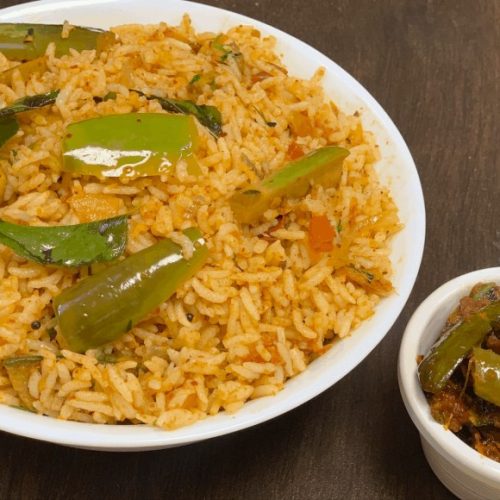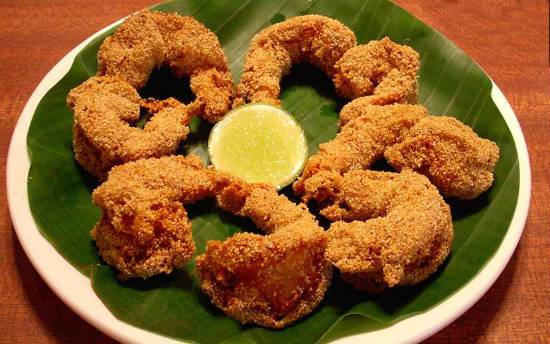Holi, the vibrant Indian festival of colours, is one of India’s most joyous and energetic celebrations. It marks the arrival of spring, winter’s end, and good over evil’s victory. While splashing colours on each other is a big part of the celebration, the sumptuous array of traditional foods accompanying the festivities is equally essential.
These dishes bring together the best of indian cuisine—sweet, savoury, spicy, and tangy—creating a memorable feast with minimal effort. Let’s dive into some mouthwatering Holi recipes that will elevate your celebrations, from savoury delights and refreshing drinks to indulgent sweets.
Savoury Delights
Savoury snacks during Holi are a perfect way to balance the sweetness of the festival’s desserts. These dishes are designed to be shared among family and friends, offering bold flavours and various toppings that will excite your taste buds.
Aloo Tikki Chaat
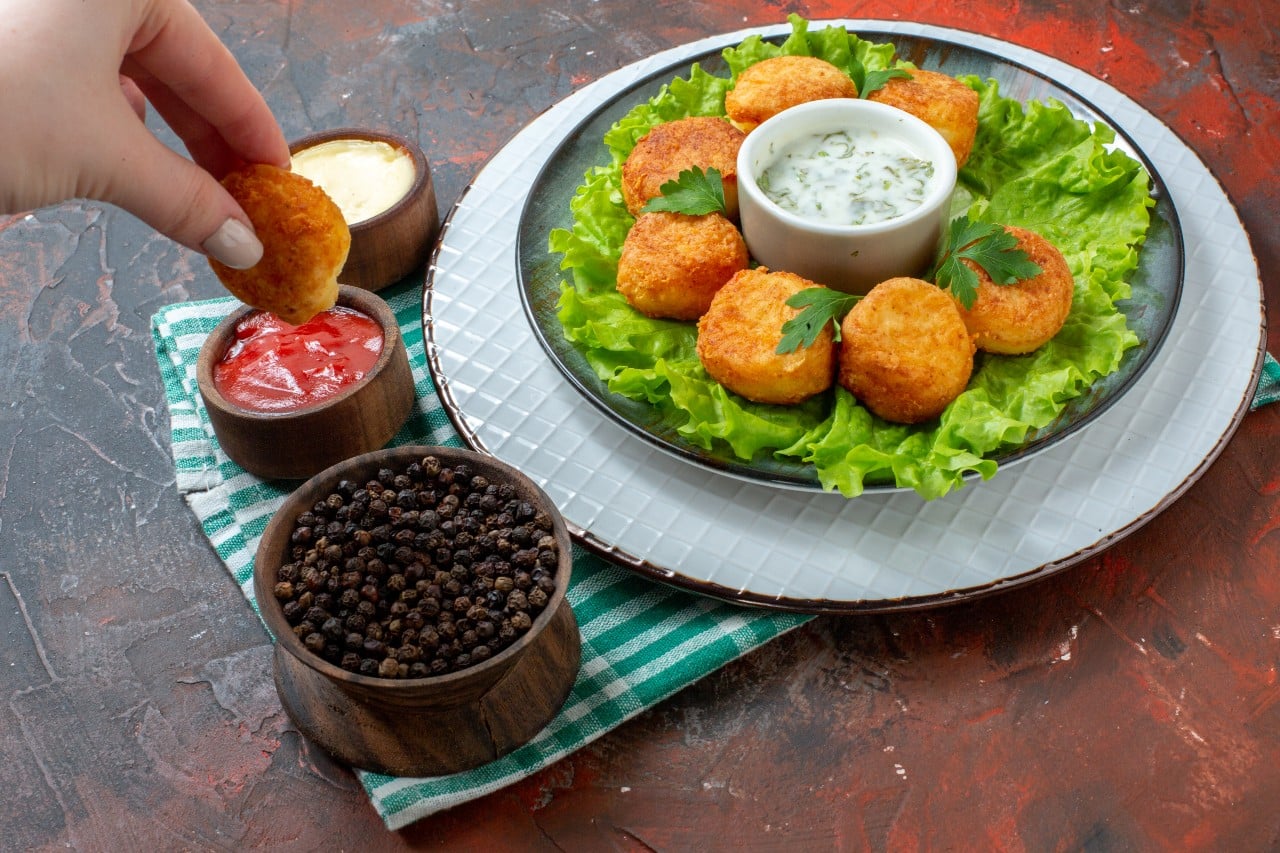
Crispy potato patties topped with yoghurt tamarind chutney and spices
Aloo Tikki Chaat is a delightful, street-food-inspired snack that combines crispy golden potato patties with a medley of tangy yoghurt, spicy chutneys, and fresh coriander. This dish is popular during Holi because of its light yet satisfying nature. The crispy tikkis topped with a cooling yoghurt mixture and sweet-sour chutneys, much like the beloved kachori, make it an irresistible treat for any Holi party.
Ingredients:
Boiled potatoes, gram flour (besan), spices (cumin powder, coriander powder, garam masala), yoghurt, tamarind chutney, chilli powder, fresh coriander leaves, and besan ladoo.
How to Prepare:
- Prepare the tikkis: Mash the boiled potatoes and mix them with gram flour, cumin powder, coriander powder, garam masala, and salt. Shape the mixture into small patties.
- Fry the tikkis: Heat oil in a pan and deep fry the tikkis until golden brown and crispy.
- Assemble the chaat: Place the fried tikkis on a plate and top them with chilled yoghurt, tamarind chutney, chilli powder, and fresh coriander leaves.
Dahi Bhalla
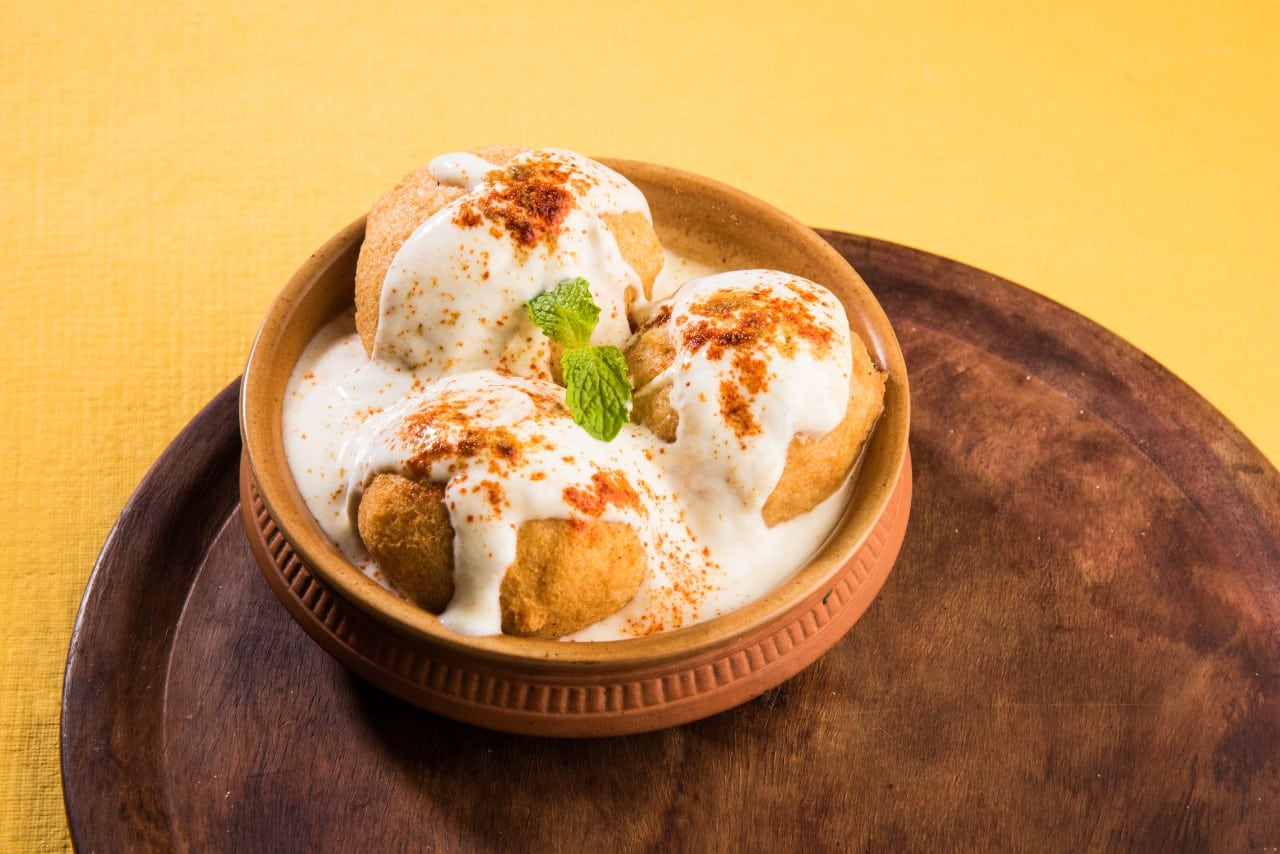
A savoury Indian dish consisting of fried lentil cakes, yoghurt, chutney, and spices
Dahi Bhalle is a classic North Indian snack that is particularly refreshing during Holi. Soft, spongy urad dal (black lentil) cakes are soaked in chilled yoghurt and topped with a variety of tangy chutneys and spices. This dish is not only flavorful but also cooling, making it perfect for the hot spring weather that accompanies the festival.
Ingredients:
Urad dal (black lentil), baking soda, yoghurt, tamarind chutney, mint chutney, chilli powder, cumin powder, salt.
How to Prepare:
- Prepare the batter: Soak urad dal overnight, grind it into a smooth batter with a little water, and add a pinch of baking soda for fluffiness.
- Fry the balls: Shape the batter into small balls and fry them in hot oil until golden.
- Soak and serve: Soak the fried balls in warm water for a few minutes, then drain and place them in a bowl of yoghurt. Drizzle with tamarind chutney, mint chutney, chilli powder, and cumin powder.
Samosas
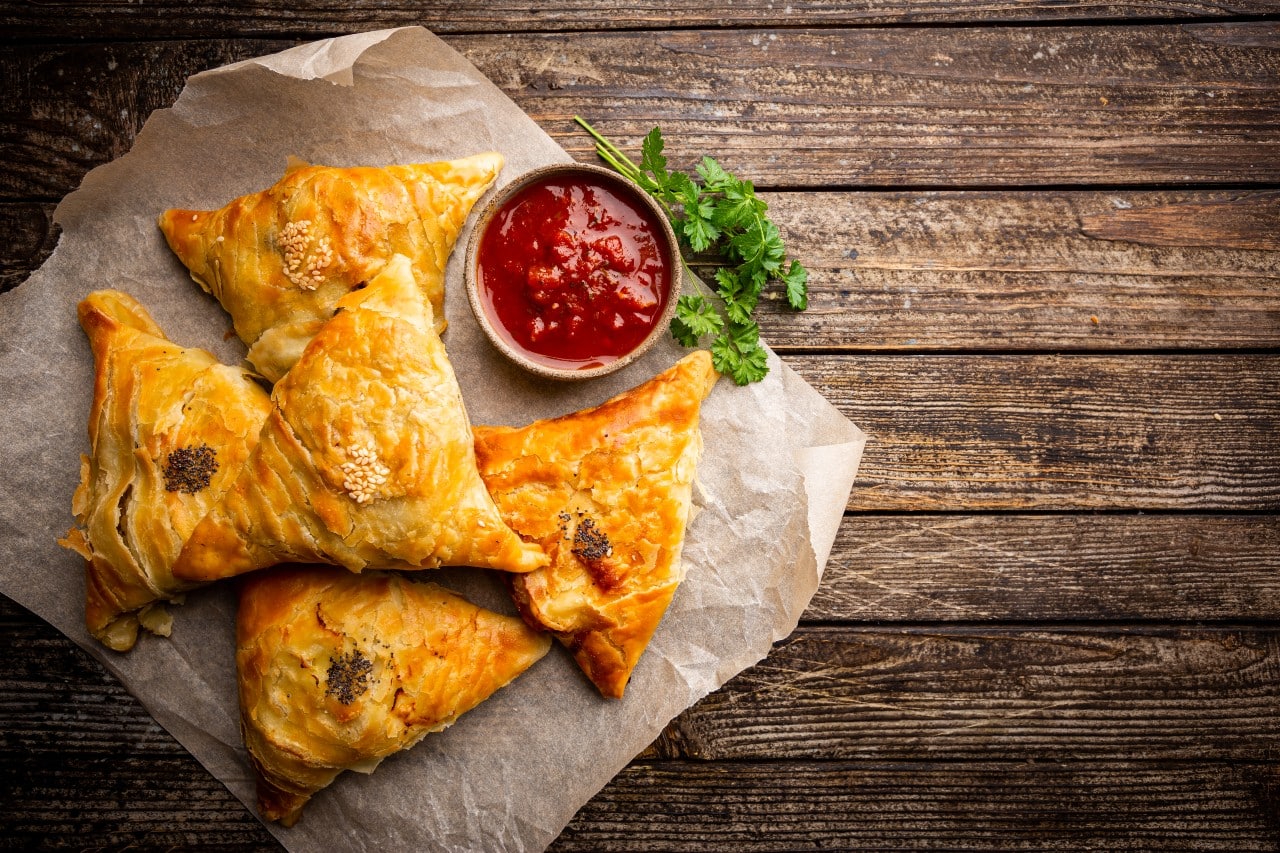
Crispy pastry filled with a savoury filling
Samosas are one of the most beloved snacks in India, and they are an essential part of any Holi celebration. These deep-fried pastries are stuffed with a delicious filling of spiced potatoes and peas. Their crunchy texture and savoury filling make them an excellent snack to enjoy before diving into the sweeter treats of the festival. You can also find more delicious recipes on my blog.
Ingredients:
Puff pastry sheets (or homemade pav dough), boiled potatoes, green peas, spices (cumin, coriander, turmeric, garam masala), and oil for frying.
How to Prepare:
- Prepare the filling: Mash the boiled potatoes and mix them with boiled peas, cumin, coriander, turmeric, garam masala, and salt.
- Shape the samosas: Cut the puff pastry into triangles, fill them with the potato and pea mixture, and seal the edges tightly.
- Fry and serve: Deep fry the samosas in hot oil until golden brown and crispy. Serve with tamarind chutney or mint chutney.
Kachori
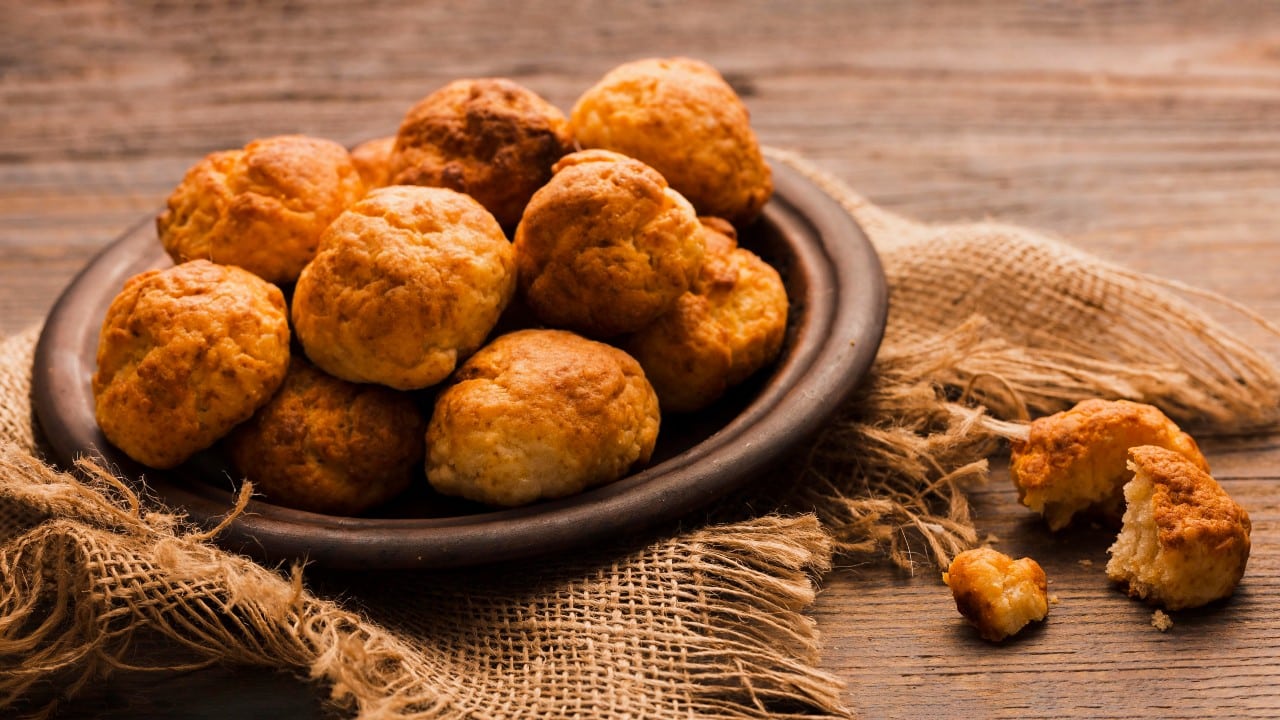
Crispy flaky pastry stuffed with spiced lentil or pea filling
Kachori is a deep-fried, flaky pastry filled with a spiced mixture, usually made of lentils or peas. This savoury treat is a popular snack during Holi and is loved for its crispy texture and flavorful filling.
Ingredients:
- All-purpose flour (maida), ghee, moong dal (yellow lentils) or peas, spices (coriander powder, fennel powder, garam masala), and oil for frying.
How to Prepare:
- Prepare the dough: Mix maida with ghee and a pinch of salt, and knead into a soft dough. Let it rest for 20 minutes.
- Prepare the filling: Cook moong dal or peas with spices until dry and aromatic.
- Shape and fry: Roll out small dough circles, add filling, seal tightly, and deep fry until golden brown.
Sweet Indulgences
No Holi celebration is complete without indulging in traditional sweets that are as colourful as the festival itself. Here are some delicious Holi sweets that will surely satisfy your sweet tooth.
Gujiya
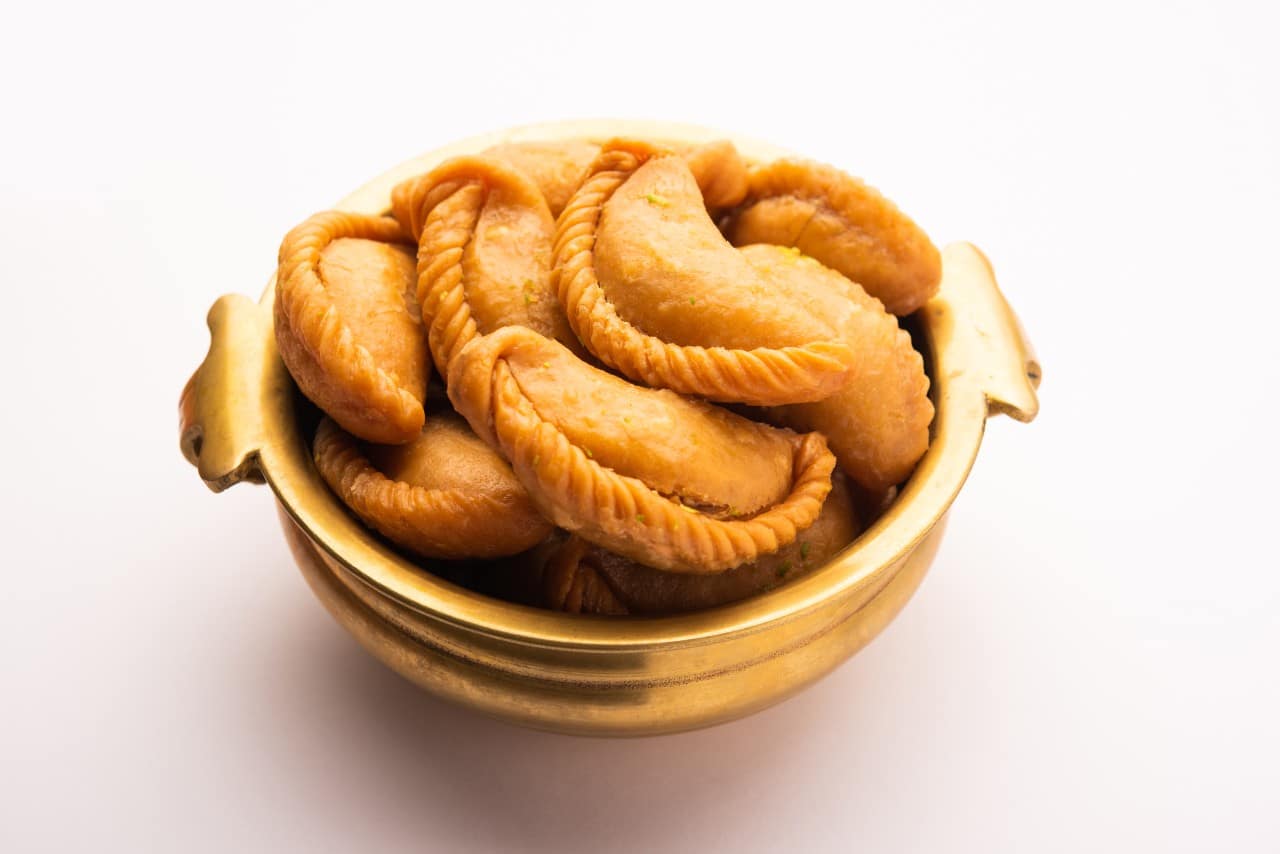
Gujiya, a traditional Indian sweet
Gujiya is a quintessential Holi sweet that features a delicate, flaky pastry filled with a mixture of khoya (milk solids), dried fruits, and coconut, alongside other traditional favourites like Gulab Jamun. The preparation may take time, but the result is well worth it. These sweet dumplings are deep-fried to golden perfection and are often enjoyed during festive occasions like Diwali and Holi, highlighting any Holi spread.
Ingredients:
Maida flour (all-purpose flour), ghee, semolina (sooji), sugar, cardamom powder, dry fruits (cashews, almonds, raisins), and oil for frying.
How to Prepare:
- Make the dough: In a bowl, mix maida, ghee, and a little water to form a smooth dough. Let it rest for 30 minutes.
- Prepare the filling: Heat ghee in a pan, add semolina and cook until it turns light golden. Add sugar, cardamom, and chopped dry fruits, and cook until the mixture thickens.
- Shape and fry: Roll out small circles of dough, place the filling in the centre, fold the dough over to form half-moons, and seal the edges. Deep fry the gujiyas until golden brown and crispy.
Thandai
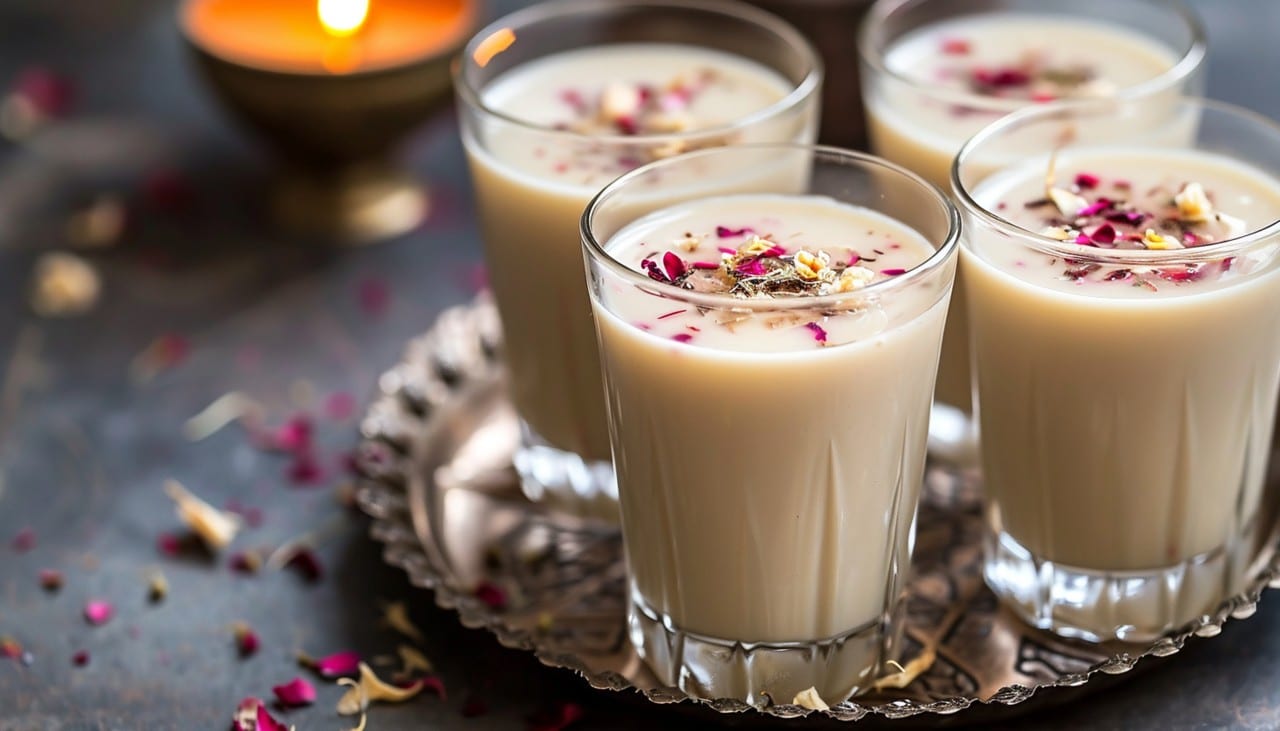
A glass of refreshing Thandai with nuts and spices
Thandai is a traditional Indian drink that is typically served during special occasions like Holi, often paired with kalakand. It’s a refreshing, creamy concoction made with milk, nuts, seeds, and aromatic spices like cardamom and saffron. This drink has a cooling effect, making it ideal for the warm weather of spring. Sometimes, bhang (cannabis) is added to Thandai for a festive twist, but the non-alcoholic version is just as delightful.
Ingredients:
Full-fat milk, badam, almonds, cashews, pistachios, cardamom powder, saffron, sugar, rose water, and water.
How to Prepare:
- Prepare the nuts: Soak the almonds, cashews, and pistachios in warm water for a few hours. Then, grind them into a fine paste.
- Boil the milk: Heat the milk and add the ground nuts, cardamom, saffron, sugar, and rose water. Stir the mixture and bring it to a gentle boil.
- Strain and serve: Strain the milk to remove any solid particles, chill the Thandai, and serve cold.
Malpua
Malpua is a traditional Indian pancake-like dessert soaked in sugar syrup. These golden, crispy-edged, soft-centred delights are a must-have during Holi festivities. They are often served with a dollop of rabri (thickened milk), enhancing their sweetness and texture.
Ingredients:
- All-purpose flour (maida), semolina (sooji), sugar, fennel seeds, milk, ghee, sugar syrup, and chopped nuts (almonds, pistachios).
How to Prepare:
- Prepare the batter: Mix maida, semolina, sugar, fennel seeds, and milk to form a smooth batter. Let it rest for 30 minutes.
- Fry the malpuas: Heat ghee in a pan, pour a ladle of batter, and fry until golden brown on both sides.
- Soak and serve: Soak the fried malpuas in warm sugar syrup for a few minutes, garnish with nuts, and serve.
Puran Poli
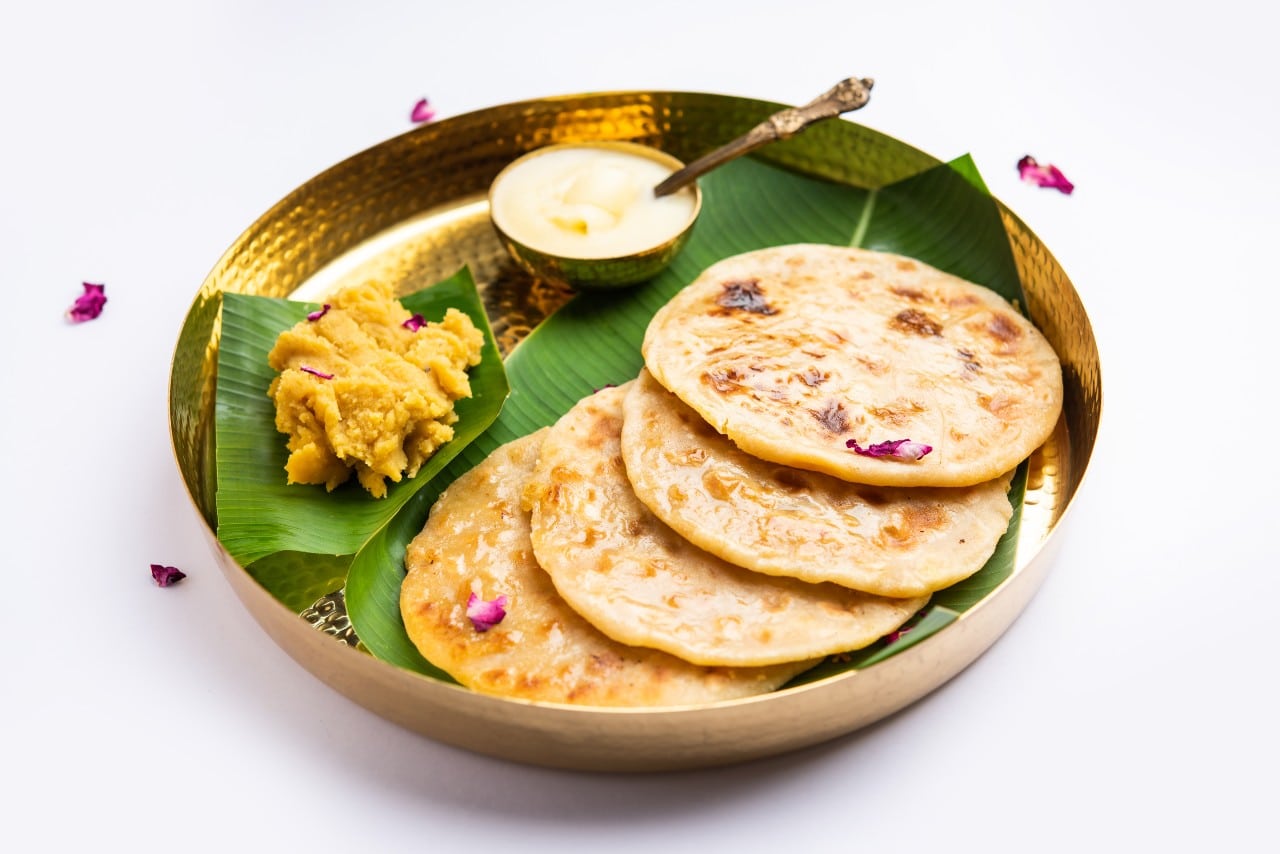
Golden flatbread stuffed with a sweet lentil filling
Puran Poli is a festive flatbread stuffed with a sweet lentil mixture made from chana dal (split Bengal gram) and jaggery. This traditional dish is enjoyed as a dessert or snack during Holi.
Ingredients:
- Chana dal, jaggery, cardamom powder, all-purpose flour (maida), ghee.
How to Prepare:
- Prepare the filling: Cook chana dal, mash it and mix it with jaggery and cardamom powder until thickened.
- Prepare the dough: Knead a soft dough with maida, ghee, and water.
- Assemble and cook: Roll out the dough, stuff with the filling, seal, and roll out again. Cook on a hot grill with ghee until golden brown.
Refreshing Drinks
In addition to the delicious food, refreshing drinks are an integral part of Holi celebrations. These drinks offer a cool respite from the heat and complement the flavorful food.
Aam Panna
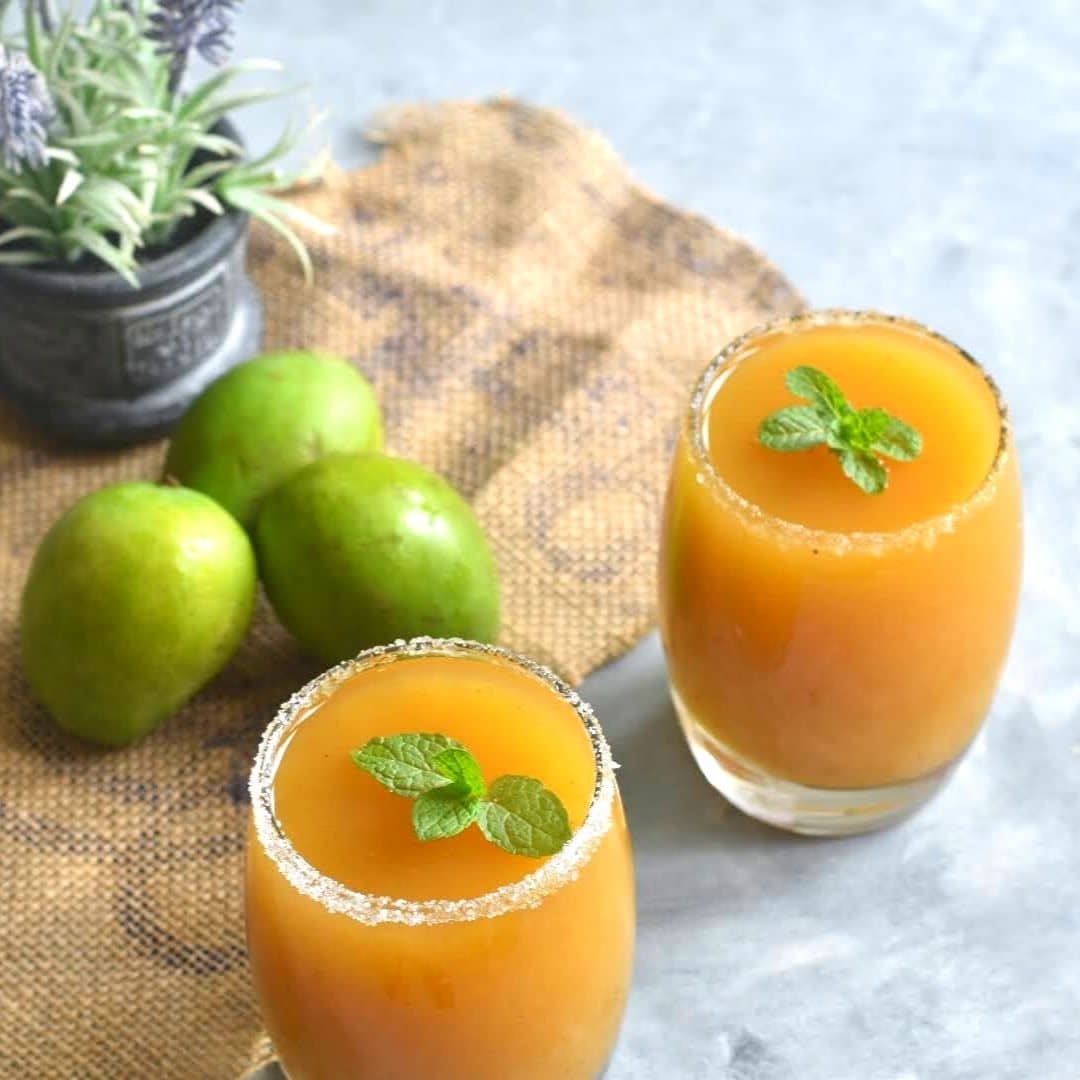
Sweet and Sour Mango Drink
Aam Panna is a tangy, sweet drink made with raw mangoes. It is a popular summer drink that helps cool the body and rehydrate you. The combination of raw mangoes with spices like black salt and cumin makes this drink the perfect way to beat the Holi heat.
Ingredients:
Raw mangoes, sugar, black salt, cumin powder, mint leaves, water.
How to Prepare:
- Boil the mangoes: Boil the raw mangoes until they soften, then peel and remove the seeds.
- Prepare the drink: Blend the mango pulp with sugar, black salt, cumin powder, mint leaves, and water.
- Serve chilled: Strain the mixture and serve it chilled with ice cubes for a refreshing treat.
Kanji is a traditional Indian fermented drink made from black carrots and flavoured with mustard seeds. Known for its tangy and mildly spicy taste, it is a refreshing and probiotic-rich beverage, perfect for Holi celebrations.
Ingredients:
- Black carrots (or regular carrots), mustard seeds, water, salt, red chilli powder, and asafoetida (hing).
How to Prepare:
- Prepare the mixture: Peel and chop the black carrots into sticks. Combine them with mustard seeds, salt, red chilli powder, and asafoetida in a large jar.
- Fermentation: Add water to the jar, cover it, and let it sit in sunlight for 3-4 days to ferment. Stir daily.
- Serve: Once tangy and fermented, strain the liquid and serve chilled.
Conclusion
Holi is a celebration of life, love, and unity, and what better way to enjoy it than with a feast of traditional Indian foods and drinks? From savoury snacks like Aloo Tikki Chaat and Dahi Bhalle to the sweet indulgence of Gujiya and the refreshing Thandai, these recipes will ensure that your Holi celebrations are filled with joy and flavour. So gather your loved ones, add some colour to your life, and enjoy this beautiful festival with these delightful dishes! Happy Holi!
Frequently Asked Questions
What are some traditional dishes prepared during Holi?
Traditional dishes prepared during Holi include Gujiya, a sweet dumpling filled with khoya and dry fruits; Thandai, a refreshing milk-based drink infused with nuts and spices; and Puran Poli, a lentil-stuffed flatbread. These dishes are enjoyed during the festive spirit of Holi celebrations.
How can I make my Holi celebration eco-friendly?
You can celebrate an eco-friendly Holi by using natural, non-toxic colours, avoiding plastic, and opting for sustainable materials for decorations.
What are some safety tips for playing Holi?
To ensure safety, avoid using chemical-laden colours, wear protective goggles, and cover your hair and skin with old clothes. Stay hydrated and avoid excessive alcohol consumption during the celebrations.
What are some fun Holi party ideas?
Organize a Holi party with colour-themed decorations, fun games like water balloon fights or musical chairs, and a buffet featuring these delicious Holi recipes. You can also add a photo booth with colourful props to capture the festive moments.

